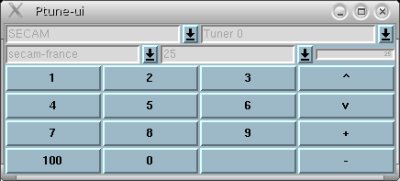
Choisissez les paramètres qui
vont bien (25 correspond à France 2). Dans le shell après
avoir choisi cette chaîne, j'ai le message suivant
frequency table now secam-france
Channel changed to 25, freq = '503250'
Un fichier ~/.ivtvrc va se créer, je l'ai légèrement modifié ainsi
[defaults]
VideoDevice=/dev/video0
FrequencyTable=secam-france
TunerNum=0
Debug=1
# options pour la commande record-v4l2.pl
OutputDirectory=/maurice/store
VideoStandard=SECAM
VideoWidth=720
VideoHeight=576
StreamType=10
Les fois suivantes quand je relance, j'obtiens comme trace
Standard: 0x007f0000
Input: 0x00000004
0 0x00003000 NTSC 1001/30000 525
1 0x000000ff PAL 1/25 625
2 0x007f0000 SECAM 1/25 625
frequency table now secam-france
Channel changed to 25, freq = '503250'
Un fichier ~/.ivtvrc va se créer, je l'ai légèrement modifié ainsi
[defaults]
VideoDevice=/dev/video0
FrequencyTable=secam-france
TunerNum=0
Debug=1
# options pour la commande record-v4l2.pl
OutputDirectory=/maurice/store
VideoStandard=SECAM
VideoWidth=720
VideoHeight=576
StreamType=10
Les fois suivantes quand je relance, j'obtiens comme trace
Standard: 0x007f0000
Input: 0x00000004
0 0x00003000 NTSC 1001/30000 525
1 0x000000ff PAL 1/25 625
2 0x007f0000 SECAM 1/25 625